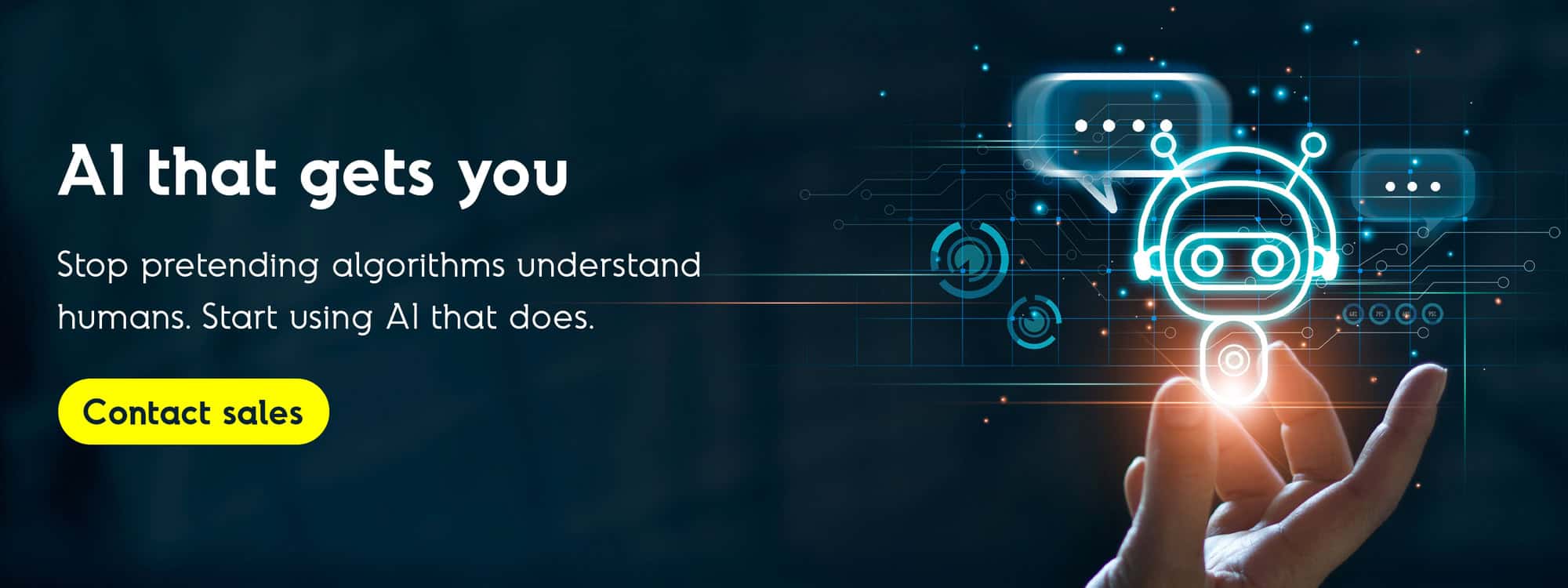Avoid these costly mistakes when deploying AI chatbots to wow your customers

Table of Contents
AI chatbots have already changed how customer service will work forever. Answering FAQs? Processing returns? Holding customers’ hands through the sales journey? No problem. Chatbots chomp through millions of daily interactions across service and sales without a hitch.
Why AI chatbots matter in customer experience (CX)
AI agents are no longer simply nice-to-have, puppy-like retrievers of information; they are grabbing centre stage on CX platforms everywhere. Get them right, and customers become fully up-to-date, primed-to-purchase ambassadors of your brand (thanks to the extreme competency of the AI). Mess it up, though, and they’re off like a rat up a drainpipe. Possibly hurling some choice Anglo-Saxon in your brand’s direction.
In this article, we’ll explore the most common mistakes businesses make with AI chatbots and show you how to improve customer experience with AI chatbots, using real-world tips and best practices.
According to research by EBI.AI, the average chatbot-only conversation lasts just under two minutes, while adding human handoff extends this to over 15 minutes. This highlights how effective properly designed chatbots can be at resolving issues quickly. And leads us to…
Mistake #1: Using generic or scripted responses
You may have been there, typing out a detailed issue only for a robotic, perhaps irrelevant reply. And this is one of the most damaging chatbot CX errors you can make.
Why it fails:
- Generic replies frustrate users.
- Scripted conversations lack empathy or relevance.
- Users quickly sense the chatbot isn’t “smart enough” to help.
How to fix it: Use natural language processing (NLP) to make bots context-aware and capable of more human-like responses. Personalise replies based on customer history, location, or product data. Avoid hard-coded trees when machine learning can adapt better.
Mistake #2: Poor handoff from bot to human
When a chatbot can’t solve a problem, it should know when to pass the baton. Too many customer support chatbots get stuck in loops or abruptly end conversations.
Why it fails:–
- Customers hit dead ends.
- Frustration builds when they must start over with a human agent.
How to fix it: Set smart escalation triggers that recognise negative sentiment, repeat questions, or urgent requests. Create seamless transitions by passing conversation history to the agent so the customer doesn’t have to repeat themselves.
Mistake #3: Not updating the chatbot regularly
Your business evolves—so should your bot. If it’s still referencing last year’s shipping policy or doesn’t know about your latest product line, you’ve got a problem.
Why it fails:–
- Chatbots give out-of-date or incorrect info.
- They can’t answer new or trending queries.
How to fix it: Establish regular feedback loops. Analyse user queries to identify gaps. Update bot training data frequently to reflect changes in services, products, or policies. Use deployment automation practices to roll out updates safely and consistently, ensuring every chatbot improvement reaches production without manual intervention.
Mistake #4: Focusing only on cost reduction
Yes, chatbots cut costs. But if your only goal is reducing headcount or deflecting tickets, you risk damaging your reputation.
Why it fails:–
- Customers feel fobbed off.
- Poor service leads to churn or negative reviews.
How to fix it: Focus on user outcomes, not just operational savings. The best bots enhance service, not replace it. Balance automation and quality by using AI to assist humans, not eliminate them.
Mistake #5: No analytics or performance tracking
If you’re not measuring how your chatbot performs, how will you improve it?
Why it fails:–
- You miss out on critical data like drop-off rates or customer satisfaction.
- Problems go unnoticed until users complain (or leave).
How to fix it: Use tools like Google Analytics, Botanalytics, or your platform’s built-in dashboard to track:
- Completion rates
- Satisfaction scores
- Most frequent queries
- Dropout points
These metrics help you spot mistakes that reduce chatbot ROI and fine-tune your performance.
Mistake #6: Overcomplicating the chatbot
Just because you can build a decision tree with 50 branches doesn’t mean you should.
Why it fails:–
- Users get lost or overwhelmed.
- Long flows feel like a maze instead of help.
How to fix it: –
- Keep interactions simple and intuitive.
- Use quick replies, clear menus, and straightforward language.
- Make it easy to start over or ask for a human.
User experience (UX) is critical. Bots shouldn’t be harder to use than your website.
Mistake #7: Ignoring mobile optimisation
A huge portion of chatbot interactions now happen on smartphones. If your bot isn’t mobile-friendly, you’re not at the races.
Why it fails:–
- Small text, poor layout, and slow loading = high bounce rates.
- Buttons or menus don’t display properly.
How to fix it: Design your chatbot interface with mobile in mind. Prioritise speed, readability, and tap-friendly buttons. Test across devices to ensure it’s responsive and accessible.
Expert tips: How to maximise AI chatbot efficiency
To avoid these pitfalls, follow these AI chatbot best practices:
- Use machine learning to continuously improve your bot’s intelligence.
- Invest in NLP to understand intent and sentiment.
- Test frequently with real users—iterate based on behaviour, not assumptions.
- Create fallback responses that redirect users to a helpful resolution.
- Monitor analytics weekly to identify patterns.
- And remember: chatbots don’t replace your team—they enhance them.
According to Master of Code, experts predict that by 2026, AI bots will power 95% of all customer service interactions, making it crucial to get your chatbot implementation right from the start.
Conclusion: How to avoid these AI chatbot mistakes
Poorly implemented chatbot agents can ruin the customer experience, but with a smart strategy, AI chatbots drive loyalty, satisfaction, and sales.
Key takeaways:–
- Personalise responses to boost engagement.
- Ensure seamless human handoffs.
- Keep your chatbot content updated.
- Track performance and act on data.
- Keep UX clean and mobile-friendly.
Want to improve your chatbot strategy and avoid these costly mistakes? Recent research shows that by 2026, a staggering 95% of customer interactions will be powered by AI, with 80% of customer service organisations using generative AI to enhance agent productivity and improve customer interactions. Additionally, recent studies reveal most customers (87.2%) report neutral or positive experiences with chatbots, while 62% of consumers actually prefer using chatbots rather than waiting for a human agent.
Worktual helps businesses build smarter bots that actually understand your customers—while boosting ROI and reducing support load.
Ready to transform your customer service? Book a demo and Get started with Worktual today.
Frequently Asked Questions
1. What are the most common mistakes businesses make with AI chatbots? Common issues include using scripted responses, failing to escalate to humans, ignoring mobile users, and not tracking performance.
2. How can poor chatbot design impact customer experience? Bad design frustrates users, reduces trust, and can lead to lost sales or negative reviews.
3. Why is it important to train and update your AI chatbot regularly? Training your chatbot ensures it stays accurate and useful as your business changes.
4. What’s the role of human agents in AI-powered customer service? Humans handle complex or emotional issues bots can’t. A good chatbot knows when to escalate.
5. How can businesses track chatbot performance and avoid CX mistakes? Use analytics tools to monitor key metrics like dropout rates, completion, and satisfaction. Iterate often to improve results.
What is Worktual?
Free your team from repetitive questions
Worktual helps you slash support costs by 60% while improving response speed and accuracy.
See it in actionRelated Posts

Why Worktual Is the #1 Drift Alternative You Need in 2026
Conversational AI has revolutionised customer engagement, lead generation, and support automation. With businesses increasingly relying on chatbots to streamline interactions, choosing the right platform is crucial. Two leading contenders in 2025 are Worktual and Drift, each catering to different business needs.

Zendesk Alternatives: Why Worktual is the Best Choice for smarter customer support
Customer service has entered an era where AI chatbots are no longer optional but essential. From rapidly scaling startups to large enterprises aiming to reduce costs, the right conversational AI can reshape customer experiences and boost business outcomes.

Top 5 Best Customer Service Solutions To Boost Retention
As customers demand faster, smarter, and more joined-together support experiences, the rise of AI-powered virtual contact centres has become impossible to ignore.

